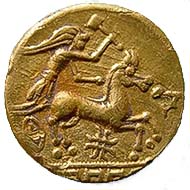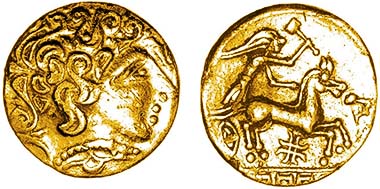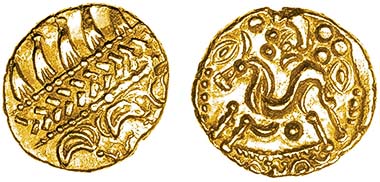Fig. 1 Gallo-Belgic hammer-god in his golden sky-chariot
November 21, 2009 – Last year an exceedingly rare gold quarter stater, minted over 2,000 years ago in the Somme valley, northern France, was found near Ringwould, Kent, by a metal detectorist. Struck c.250-225 BC in the land of the Ambiani tribe, who gave their name to Amiens, this small gold coin (only 13mm) was copied from a copy of a gold stater of Philip II of Macedon, 382-336 BC.
Fig. 2 Gold quarter stater of Ambiani tribe
On one side is the head of Apollo with a lyre hidden in his curly hair. On the other we see a Celtic hammer-god driving his chariot across the sky. He has long flowing hair and holds a large hammer in his right hand. He may be Sucellos ‘the good striker’. A big bee – the Celts made mead with honey – buzzes before the horse’s snout. Only one other specimen of this coin is known and that is in the Bibliothèque Nationale, Paris. The above coin will be sold by auction early in March.
Fig. 3 New type of gold stater of Corieltavi tribe
In the same sale is an equally rare gold stater struck c.60-50 BC by the Corieltavi tribe of Lincolnshire. It comes from a small hoard of four gold staters and a gold pellet found in 2007 near Saxilby, Lincs., by metal detectorists Geoffrey Rippon and Paul Virr. Two of the staters are of a new type, previously unrecorded. One was acquired by the British Museum. The other, shown here, will be sold by auction. For further details email liz(ad)celticcoins.com
by Chris Rudd







